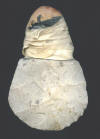

(up-dated 29/Mar./2016)
 (Photo LK)
(Photo LK)
Note the hafting method with the wood butting the top of the chert hoe.
This was used to put less pressure on the rawhide and more on the wooden
handle.
These two Mill Creek hoes were made for the Manitoba Museum, in March 2009.
Here
are both sides of the original Mill Creek nodule for hoe # 1.The rough
nodule weighed 6 lbs.-13 oz. and measured 20 cm. X 17.9 cm. or 7 7/8" X 7"
Here are both sides of Hoe # 1. It
measures 14.3 cm (5 5/8") long by 10.6cm. (4 1/8") wide. It weighs
1lb.-1oz. and took only about 20 minutes to manufacture.
Here are both sides of Hoe #2. It
weighed 15 oz. and measured 15.6 cm. long by 9 cm. wide.
Here are 3 views of Hoe #2
after it was hafted. The dogwood handle measured 37.5 cm. long by 6 cm.
wide, or 14 3/4" long by 2 3/8" wide. It was lashed using whitetail deer
rawhide glued into place with a mixture of hide glue and charcoal.
MILL
CREEK SPADE
This is another Mill Creek hoe, sometimes
called a spade. The top end, often is left with an unfinished portion to
assist in the wooden hafting. The unfinished portion gives a flat spot for
the chert to abutt the wood. Both notched and unnotched hoes were used to
till the fertile soil of the American Bottoms. The corn and other crops
produced with these tools fed thousands of people for over 200 years.
This hoe was completed on November 1st, 2008. This is also made of Mill
Creek chert but this one is the spade type.
Here's a spade Larry made last summer(2007). The chert (flint) spade is 7 5/8 in. long.
Hoes and spades were also made of Kaolin flint or chert.
![]() (Photo Bill Iseminger)
(Photo Bill Iseminger)
 (Photo Pete Bostrom)
(Photo Pete Bostrom)
Like most tools, hoes have a second
use. Here, Larry cuts some thatch with the notched hoe. He has backed over
the Big Blue Stem and holds the stems tightly in his left hand while
striking with the hoe. Only 2 or 3 swings are needed to cut the clump. Larry
will then lay the clump in front of him and back over the next clump to be
cut. Thatch can be cut very effectively this way, using only a stone hoe.
(Photo Bill Iseminger)
Here's a short video of Larry using his notched hoe to cut big blue stem prairie grass. http://www.youtube.com/watch?v=ur0EWa6nUaA
(photos LK)
These are pictures of a Mississippian shell hoe Larry made in November 2004.
Another one of Larry's Mill Creek notched hoes. The stone was knapped in 2005 and it was hafted in April 2007.
A Mississippian, Crescent Quarry Burlington, notched hoe. The handle is hackberry. The rawhide lashings have not been applied, here. Made in 2015.
Another Mississippian, Crescent Quarry Burlington, notched hoe, with the rawhide lashings in place.. The handle is also hackberry. Made in 2015.
Here, I apply the pitch, to the hoe.
https://www.youtube.com/watch?v=RyN2krE21VY
Here, I demonstrate how the notched hoe can be used to cut prarie grass (Big Blue Stem)
https://www.youtube.com/watch?v=ur0EWa6nUaA